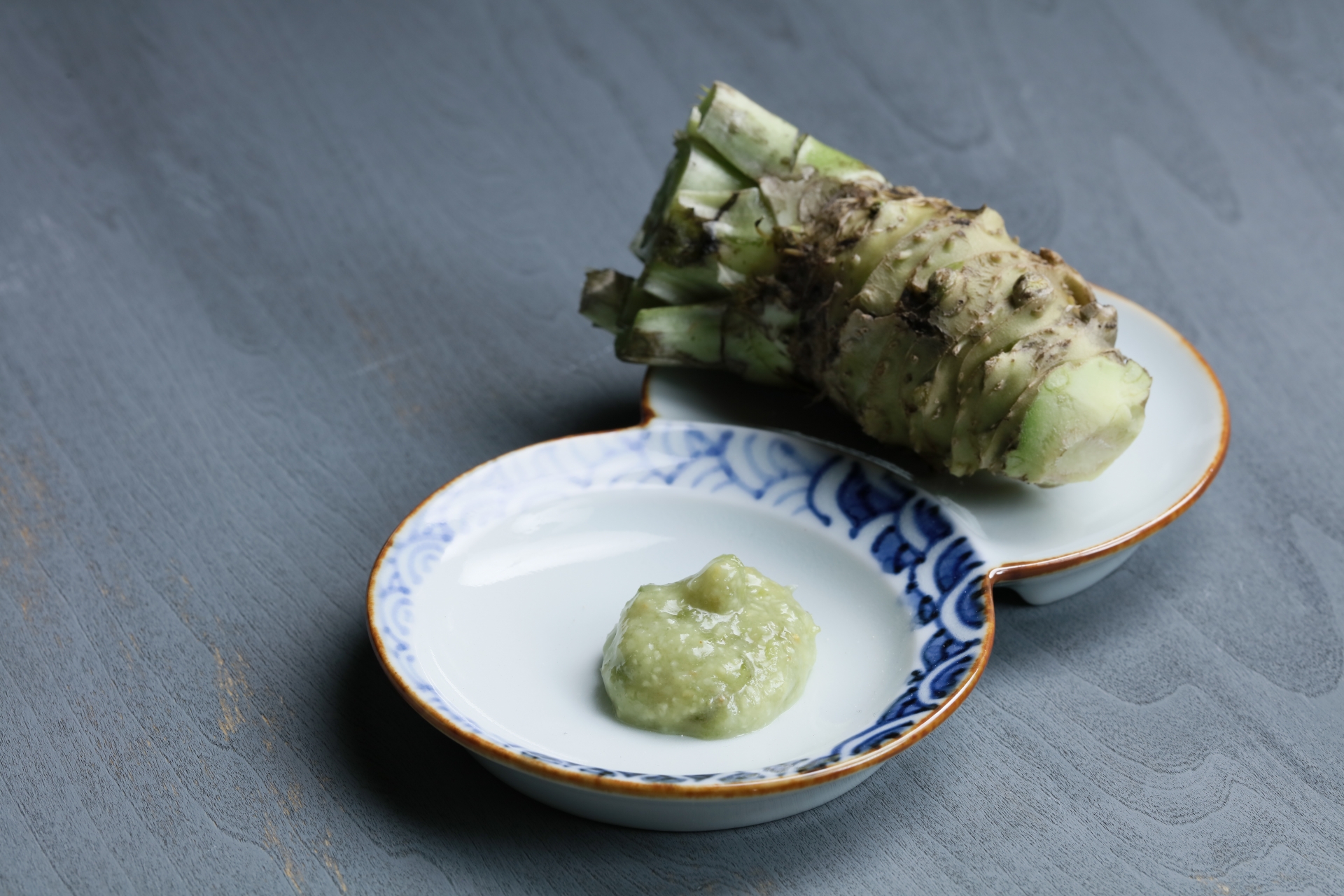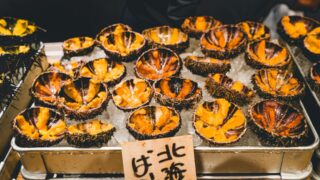
Stefanie Akkerman moved from the Netherlands to Japan in 2013 with her Japanese husband and son. She jumped into the niche of Dutch tour guiding in Tokyo and Kamakura in 2015 and occasionally writes articles about all the great sights and activities Japan has to offer. She loves (Japanese) food, and to work that all off she goes diving, snorkeling, cycling, or hiking.
This post may contain some affiliate links. When you click through and make a purchase we may receive some commission, at no extra cost to you.
Anyone who has ever eaten sushi will be familiar with the sharp tinge of that little green streak of wasabi that sits between the rice and the topping. Different from the spiciness from common seasoning such as red peppers that burn in your mouth and throat, wasabi goes straight to your nose to deliver a funky punch with each bite.
Besides its spiciness, wasabi also has a slightly sweet and fresh flavor that adds an extra dimension to your dish. But what is wasabi? How can you best enjoy it? And which wasabi-related places can you visit in Japan? Learn all you need to know about this interesting and quintessential Japanese condiment!
1. What is Wasabi

Although many people think of wasabi as Japanese horseradish, real wasabi is actually made from a different plant, the Wasabia Japonica. While this plant is related to horseradish, it is not the same plant. Wasabi is made of the stem of the plant that grows underground like a root, and this is also where most of the flavor accumulates.
In its simplest form, you can take a freshly harvested and cleaned stem and grate the wasabi paste right off. This pure wasabi has a rather light green color and a gritty texture, has a rather mild, herb-like flavor, and while it does have a slight spiciness to it, it is by far not as hot as the wasabi most of us are used to eating.
2. Real Wasabi or Fake Wasabi?

Did you know that about 95% of the wasabi that is served in Japan is actually fake wasabi? Internationally, the number is even worse as 99% of wasabi that you see outside of Japan is of the fake variety. This fake wasabi is actually made of horseradish, which started the confusion about what wasabi is actually made of.
Besides horseradish, fake wasabi also contains mustard, food coloring, and other additives to make it last longer. It is the mustard that delivers the kick, which is actually much stronger than the tinge you feel when you eat real wasabi.
The main reason that so many restaurants and other food providers use fake wasabi is that real wasabi is very expensive because it is so hard to grow. It takes exactly the right circumstances in terms of temperature, sunlight, and water quality, making it a rare vegetable. For most farmers, it is simply too expensive to create the right circumstances so there are only a few farms that actually grow wasabi. Furthermore, fake wasabi also lasts longer so it is much easier to deal with in a restaurant’s supply chain. Real wasabi needs to be eaten soon after it’s been grated and an opened stem doesn’t last very long. So if you want to eat real wasabi with your meal, you will have to go to a high-end sushi restaurant in Japan as cheaper sushi restaurants and most other restaurants don’t serve real wasabi.
3. Health Benefits of Wasabi

Besides the fact that wasabi is a flavorful condiment that complements certain foods well, having a bit of wasabi also has health benefits. Here are some of wasabi’s known healthy properties:
- Antibacterial effects: one of the main reasons that people started adding wasabi to sushi is because of its antibacterial effects. Raw fish has some degree of possibility to convey foodborne illnesses, but this risk is mitigated by the addition of wasabi.
- Anti-inflammatory effects: inflammation is the root cause of many diseases and ailments, so any foods that contain components that put a brake on inflammation, including wasabi, are helpful in the prevention of many illnesses including cancer and diabetes.
- Stronger bones: wasabi may help increase bone density, which is especially important for older adults.
- Weight loss: eating the leaves of the wasabi plant may aid with weight loss by inhibiting the growth of fat cells.
4. Cooking with Wasabi

Besides sushi, there are other foods that go well with a dot of wasabi. A popular way to serve wasabi is next to some fine slices of wagyu beef. The fatty, flavorful beef that comes from Japanese cattle that was raised under stringent standards doesn’t need much in ways of flavoring as it is good by itself with just a sprinkling of salt and pepper. However, adding a bit of wasabi to each bite does bring out the best of the taste and gives it a nice extra dimension.

Another food that is often served with a small dot of wasabi on the side is zaru soba, buckwheat noodles that are first boiled and then cooled down to be enjoyed cold. The wasabi is usually mixed into the dipping sauce together with some scallions by the diner. It is a fresh, healthy dish that is usually enjoyed during Japan’s hot summer.
Are you a fan of sandwiches? Then you could try switching regular mustard for wasabi. Any sandwich that goes well with yellow mustard will also be a match with wasabi. If you enjoy making salads, try adding a bit of wasabi to a light, sour dressing to literally spice things up a little and give your salad an extra punch. Rich and hearty soups can also benefit from a bit of wasabi to add some spice to your broth.
5. Visiting a Wasabi Farm in Japan

The best place to visit if you want to learn more about the history of wasabi, its cultivation, and to taste some scrumptious snacks made with real wasabi is the Daio Wasabi Farm in Nagano prefecture. As one of the oldest farms in Japan and the largest wasabi farm in the world, this is a destination that those with an interest in farming and cooking will love. There is a museum, several shrines, and restaurants on the premises, but the main attraction is that you can walk around the farm and see how wasabi is grown.
To get to Daio Wasabi Farm, take the train to Hotaka Station and rent a bicycle at one of the two shops right next to the station. It is 2.7 kilometers away from Hotaka Station, so you could also walk or take a taxi. The farm is open every day, and there is no entrance fee.
Website: Daio Wasabi Farm

One of the best parts of traveling in Japan is that you get to enjoy Japan’s rich food culture. Whether you want to go to that special place that actually does serve real wasabi, experience the Japanese street food culture, enjoy yourself in an izakaya, discover the best sake pairings, or simply sample all of the best Japanese gastronomy has to offer, actually coming to Japan to do all that is by far the best way. If you’re interested in a local food-focused tour in Japan, we offer fun and delicious food tours in cities like Tokyo, Kyoto, Osaka, and Kanazawa. Book your favorite food tour before you travel and reserve your spot!
Japan Wonder Travel Food Tours
Japan Wonder Travel is a travel agency that offers guided tours throughout Japan.
From private walking tours to delicious Food and Drink tours, we can help organize the best tours just for you! If you want to explore Japan and learn more about the history and backstories of each area you are traveling in, our knowledgeable and friendly guides will happily take you to the best spots!
In addition, we can provide you with any assistance you may need for your upcoming trip to Japan, so please feel free to contact us if you have any questions or need some help!
▶Tokyo Tsukiji Fish Market Food and Drink Tour
Explore the most lively and popular fish market in Tokyo where you will have the chance to try some of the local’s favorite street foods and sake along with your friendly English speaking guide!

▶Shinjuku Bar Hopping Tour: Experience Tokyo’s Nightlife in Izakaya
Check out the best spots in Shinjuku while bar hopping through the lively and vibrant area. Try some delicious local food and drink as you explore the narrow yet photogenic alleys that the town has to offer. Experience Japanese izakaya culture and drink in Shinjuku like the locals!

▶Explore Nishiki Market: Food & Culture Walk
If you’re looking to learn more about the culture and the local cuisine of Kyoto, this is the perfect tour for you! Take part in this Kyoto food and drink tour and explore the 400-year-old market and the surrounding areas.

Follow us on Instagram, Facebook, Twitter, and TikTok for more travel inspiration. Or tag us to get featured!
Happy traveling!





